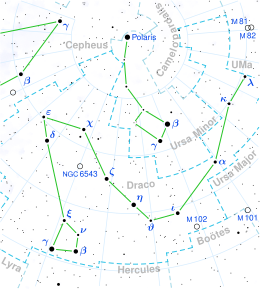Delta Draconis
| Observation data Epoch J2000 Equinox J2000 |
|
|---|---|
| Constellation | Draco |
| Right ascension | 19h 12m 33.30197s |
| Declination | +67° 39′ 41.5456″ |
| Apparent magnitude (V) | 3.07 |
| Characteristics | |
| Spectral type | G9 III |
| U−B color index | +0.78 |
| B−V color index | +1.00 |
| Astrometry | |
| Radial velocity (Rv) | +24.8 km/s |
| Proper motion (μ) |
RA: +95.74 mas/yr Dec.: +91.92 mas/yr |
| Parallax (π) | 33.48 ± 0.10mas |
| Distance | 97.4 ± 0.3 ly (29.87 ± 0.09 pc) |
| Absolute magnitude (MV) | +0.62 |
| Details | |
| Mass | 2.32 M☉ |
| Radius | 11 R☉ |
| Luminosity | 59 L☉ |
| Surface gravity (log g) | 2.98 cgs |
| Temperature | 4,820 K |
| Metallicity [Fe/H] | –0.27 dex |
| Rotational velocity (v sin i) | 8 km/s |
| Age | 0.8 Gyr |
| Other designations | |
| Database references | |
| SIMBAD | data |
Delta Draconis (δ Draconis, abbreviated Delta Dra, δ Dra), also named Altais, is a yellow star in the constellation of Draco. It has an apparent visual magnitude of 3.0, making it easily visible to the naked eye. Parallax measurements with the Hipparcos satellite yield a distance estimate of 97.4 light-years (29.9 parsecs) from the Sun.
Delta Draconis is a giant star with a stellar classification of G9 III. This indicates that, at an estimated age of 800 million years, this star has exhausted the supply of hydrogen at its core and entered a later stage in its evolution. The angular diameter of the star is estimated as 3.37 ± 0.06 mas. At a parallax of 32.54 mas, this corresponds to a physical radius equal to 11 times the solar radius. It is radiating 59 times the luminosity of the Sun from its outer atmosphere at an effective temperature of 4,820 K. At this temperature, it is giving off the yellow-hued glow of a G-type star. With a mass 2.32 times that of the Sun, this star will end its life as a white dwarf.
δ Draconis (Latinised to Delta Draconis) is the star's Bayer designation.
It bore the traditional names Aldib, Altais (the goat) and Nodus Secundus. The title Altais was derived from Arabic Al Tāis "the Goat", the association of this star, along with Pi Draconis, Rho Draconis and Epsilon Draconis (Tyl). According to a 1971 NASA catalog of stars, Al Tāis or Tais were the title for three stars : Delta Draconis as Altais, Pi Draconis as Tais I and Rho Draconis]] as Tais II (exclude Epsilon Draconis). In 2016, the International Astronomical Union organized a Working Group on Star Names (WGSN) to catalogue and standardize proper names for stars. The WGSN approved the name Altais for this star on 21 August 2016 and it is now so entered in the IAU Catalog of Star Names.
...
Wikipedia

